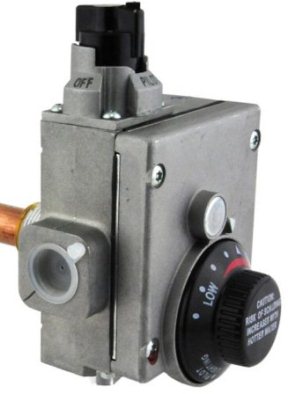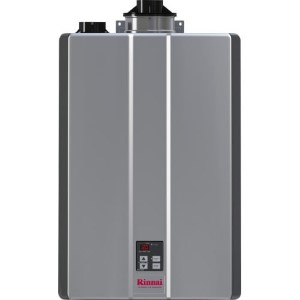- Home
- Water Tank Heater
- Replacing a Water Heater Gas Valve
Instructions of How to Replace a
Water Heater Gas Valve
Find out how to remove and replace a water heater gas valve in a few easy steps. How safely to change the temperature on the gas control valve.
This article will cover the most popular and used gas valves: White Rodgers, Robert Shaw, and Honeywell, all used in atmospheric, direct, and power-vent water heaters, which utilize the pilot light element. These three models can be found on most heating units from AO Smith, Rheem, State, American, Bradford White, GE, Kenmore, and other popular manufacturers.
 Gas control valve with a thermostat
Gas control valve with a thermostatA water heater gas valve is one of the most important elements, and as part of the manifold/burner assembly, it is located in the lower section of the gas heater. It comes with several elements attached: manifold tube, pilot tube, temperature probe, high limit probe, thermal fuse, piezo igniter, and thermocouple.
Some valves include two and some three buttons/knobs; one is for gas, one to change the temperature, and one to activate the pilot. This is where you start or turn off heating, set, adjust, and control the temperature.
The gas valve is vital in heating because your safety and correct heating operation directly depend on its proper work.
How a gas water heater works
Gas water heaters get the cold water through the dip tube and from a cold water supply.
The thermostat probe, which is part of the gas control valve, senses the temperature of the water inside the tank. If the thermostat dial is set to a temperature higher than the temperature of the water, it sends the signal to the gas control valve to open.
Water heaters equipped with the pilot light require you to set the knob to pilot mode, and once activated, it will get an uninterrupted gas supply, no matter if there is a call from the thermostat.
On the other side, the gas valve will open gas to the gas burner only if there is a call for heating.
As the gas flows to the gas burner, it gets lit by the pilot, and then the heating process starts. Part of the pilot light assembly is the thermocouple used to make sure that the flame is still there. If it is not, the unit stops the gas flow and shuts down the unit. The thermocouple is designed to send minimal electrical current (in millivolts) to the gas valve and its electromagnet to keep it open.
Once the temperature of hot water reaches the value set on the thermostat, the gas flow stops, so as heating.
How to remove a gas control valve
If you require professional assistance, contact your local water heater expert! Get FREE estimates here!
- Turn the gas control valve on the heater clockwise to the OFF position (counter-clockwise for the Honeywell model). If you own the water heater with the White-Rodgers gas valve, the knob must be depressed before switching to the OFF position.
- Turn the gas supply OFF to the unit by using the manual shut-off valve located beside the heater.
- Turn the water supply OFF.
- Drain a water heater.
- Disconnect and remove the piezo igniter, manifold tube, pilot tube, thermal switches, and thermocouple, but be careful about the direction of the thread. The thermocouple has the right-hand thread; LP uses the left-hand thread on the manifold tube, for example.
- Use the correctly sized threaded pipe and put it into the inlet to unscrew and remove the valve. Avoid using the pipe wrench to grip the valve. It is essential to avoid putting any objects inside the inlet or outlet to prevent any damage.
How to replace a gas control valve
- Use the Teflon tape or approved pipe compound when installing the gas valve onto the water heater and when reconnecting the gas tube.
- Use the threaded pipe to screw the valve back, but do not overtighten as it may damage the valve and cause the gas to leak.
- Reattach the piezo igniter, manifold tube, pilot tube, thermal switches, and thermocouple (pay attention to the thread direction).
- Be sure that there isn't anything left in the combustion chamber that might affect the proper combustion, dirt, and debris that can enter the gas valve and cause it to malfunction. Ensure that there are no cracks, loose connections, etc.
- Refill the water tank heater, open the hot water tap for several minutes to purge the outstanding air.
- Test the gas valve for gas leaks. You can use a foamy soap/water mixture on the sponge and apply it to all gas connections. If you see any bubbles, there is a leak, and corrections should be made.
- Use the lighting instructions found on the heater (label) or the user guide to start the water heating.
Adjusting the temperature
A gas control valve is equipped with a temperature dial with different settings, which allows the change of the temperature from its minimum to the maximum (cold and hot). It has the most economical and safe setting, which is around 120 F. There is also a vacation mode, so there is no need to turn the unit off when away – it will maintain the minimum temperature and prevent potential issues.
Gas water heaters are factory set at 120-125 F as the optimum temperature safe for kids. The recommended temperature from the manufacturers is between 120 and 140 F, making it suitable for showers and dishes. The clockwise direction increases the temperature, while counter-clockwise, lowers.
Whatever temperature you select, the water heater will turn the unit OFF at this temperature all the time unless you change it.
One important note: if the water heater gas valve is broken, do not attempt to repair it; replace it. It is even better if you call the technician. According to the manufacturers, this element is not set up for service.
Troubleshooting
When the gas control valve is not working or has problems, the most common complaints are "no hot water" or "not enough hot water".
Before any work, always check if there is any gas supply disruption or problems with the pressure.
If you followed the instructions to light the pilot, but it doesn't stay lit, you might have a problem with the thermocouple or gas valve.
If these elements are working as they should check the pilot tube and orifice as they might be clogged.
Note: No matter what happens to the gas control valve, the pilot button stuck, or it doesn't want to turn, or the high limit switch got activated, do not try to repair the valve. Always buy and install a new one.
If you are not confident of replacing a gas valve or not sure how to deal with the problem, it is recommended to contact a professional.
Related
- Home
- Water Tank Heater
- Replacing a Water Heater Gas Valve


